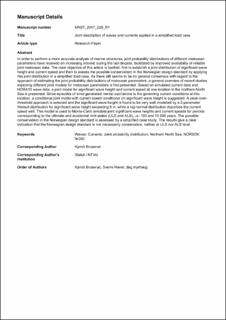| dc.contributor.author | Bruserud, Kjersti | |
| dc.contributor.author | Haver, Sverre | |
| dc.contributor.author | Myrhaug, Dag | |
| dc.date.accessioned | 2022-12-15T12:44:07Z | |
| dc.date.available | 2022-12-15T12:44:07Z | |
| dc.date.created | 2018-02-01T09:33:38Z | |
| dc.date.issued | 2018-03 | |
| dc.identifier.citation | Bruserud, K., Haver, S., Myrhaug, D. (2018) Joint description of waves and currents applied in a simplified load case. Marine Structures, 58, 416-433. | en_US |
| dc.identifier.issn | 0951-8339 | |
| dc.identifier.uri | https://hdl.handle.net/11250/3038014 | |
| dc.description.abstract | In order to perform a more accurate analysis of marine structures, joint probability distributions of different metocean parameters have received an increasing interest during the last decade, facilitated by improved availability of reliable joint metocean data. There seems to be no general consensus with regard to the approach of estimating joint probability distributions of metocean parameters and a general overview of recent studies exploring different joint models for metocean parameters is presented. The main objective of this article is twofold: first to establish a joint distribution of significant wave height and current speed and then to assess the possible conservatism in the Norwegian design standard by applying this joint distribution in a simplified load case. Based on NORA10 wave data and simulated current data, a joint model for significant wave height and current speed at one location in the northern North Sea is presented. Since episodes of wind-generated inertial oscillations are governing the current conditions at this location, a joint conditional model with current speed conditional on significant wave height is suggested. A peak-over-threshold approach is selected. The significant wave height is found to be very well modelled by a 2-parameter Weibull distribution for significant wave height exceeding 8 m, while a log-normal distribution describes the current speed well. This model is used to Monte-Carlo simulate joint significant wave heights and current speeds for periods corresponding to the ultimate and accidental limit states (ULS and ALS), i.e. 100 and 10 000 years. The possible conservatism in the Norwegian design standard is assessed by a simplified case study. The results give a clear indication that the Norwegian design standard in not necessarily conservative, neither at ULS nor ALS level. | en_US |
| dc.language.iso | eng | en_US |
| dc.publisher | Elsevier Ltd. | en_US |
| dc.rights | Attribution-NonCommercial-NoDerivatives 4.0 Internasjonal | * |
| dc.rights.uri | http://creativecommons.org/licenses/by-nc-nd/4.0/deed.no | * |
| dc.subject | marin teknologi | en_US |
| dc.title | Joint description of waves and currents applied in a simplified load case | en_US |
| dc.type | Peer reviewed | en_US |
| dc.type | Journal article | en_US |
| dc.description.version | acceptedVersion | en_US |
| dc.rights.holder | © 2018 Elsevier Ltd. All rights reserved. | en_US |
| dc.subject.nsi | VDP::Teknologi: 500::Marin teknologi: 580 | en_US |
| dc.source.pagenumber | 416-433 | en_US |
| dc.source.volume | 58 | en_US |
| dc.source.journal | Marine Structures | en_US |
| dc.identifier.doi | 10.1016/j.marstruc.2017.12.010 | |
| dc.identifier.cristin | 1560185 | |
| cristin.unitcode | 217,8,5,0 | |
| cristin.unitname | Institutt for maskin, bygg og materialteknologi | |
| cristin.ispublished | true | |
| cristin.fulltext | preprint | |
| cristin.qualitycode | 2 | |

